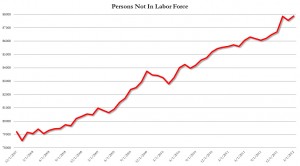
It is Friday, and you know what that means. Job numbers are out, and depending on your political persuasion as we head into this predictably grueling election season, your initial reaction is going to be different.
 Today the unemployment rate in the United States, known as U3 on the six level scale of measuring unemployment, dropped from 8.3% to 8.2%. Liberals and the Obama Administration are likely jumping with joy. They are attempting to trumpet this 10th of a percentage drop as something momentous, showing a far greater trend that somehow suggests that the failed policies of the last three years just took a bit longer and will need some more time in the oven. Of course, that is not what is going on here.
Today the unemployment rate in the United States, known as U3 on the six level scale of measuring unemployment, dropped from 8.3% to 8.2%. Liberals and the Obama Administration are likely jumping with joy. They are attempting to trumpet this 10th of a percentage drop as something momentous, showing a far greater trend that somehow suggests that the failed policies of the last three years just took a bit longer and will need some more time in the oven. Of course, that is not what is going on here.
U3, the official unemployment rate in the United States, is defined as anyone who is out of work but actively looking for work. This definition excludes three key sets of workers:
- Discouraged workers (those who have given up looking because no jobs are available to them)
- Marginally attached workers (those who have looked in the last year but not the last month for reasons other than discouragement)
- Marginally affected workers (those who have been economically effected by a substantial cut in hours or pay but are still technically working)
The most important of these groups are 1 and 2 in my opinion, as the 3rd are technically working. U5 includes discouraged workers and marginally attached workers.
Today’s numbers for U3 told us that 120,000 jobs were added to the economy this month. That sounds good, I suppose, when you do not consider the fact that the expected increase was supposed to be over 200,000. This mont also saw the lowest amount of job growth since October 2011.
The numbers also told us that roughly 88 million people are now being considered “outside the workforce.” Those are the people counted in group 1 and 2 above. According to the way this has been tracked since the government began tracking unemployment, we are near record highs for people outside the workforce.
This is nothing to celebrate at all. Of the estimated 310 million people that live in this country, 88 million are not working, but also not counted in unemployment. Taking a look at the chart below, it is easy to imagine how a steep and constant increase of workers “leaving” the workforce would bring down the unemployment rate and make it appear as though things are improving, when they very clearly are not at the pace the U3 rate suggests. (Click the chart to enlarge).
We can argue all day and night why our recovery is beyond sluggish, but the fact is that while things are improving (because lets face it, adding only 120,000 jobs is still better than losing 120,000 or more), they are not improving fast enough to keep up with the rhetoric of the Obama Administration or the promises he once made.



